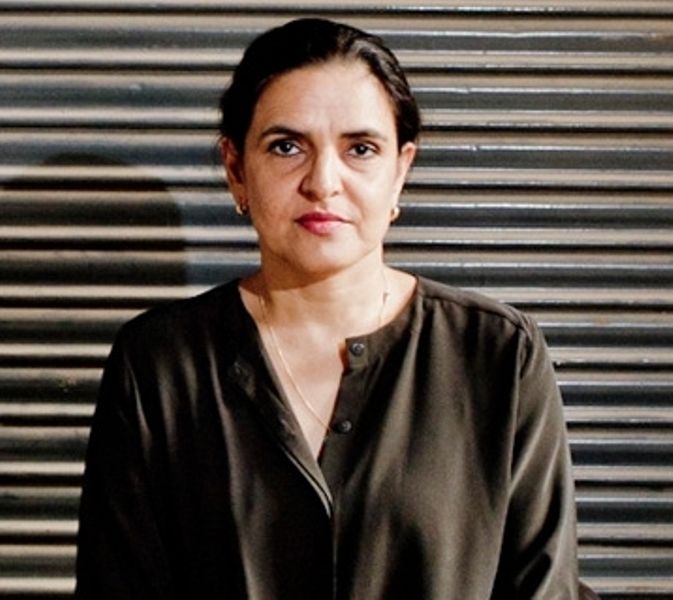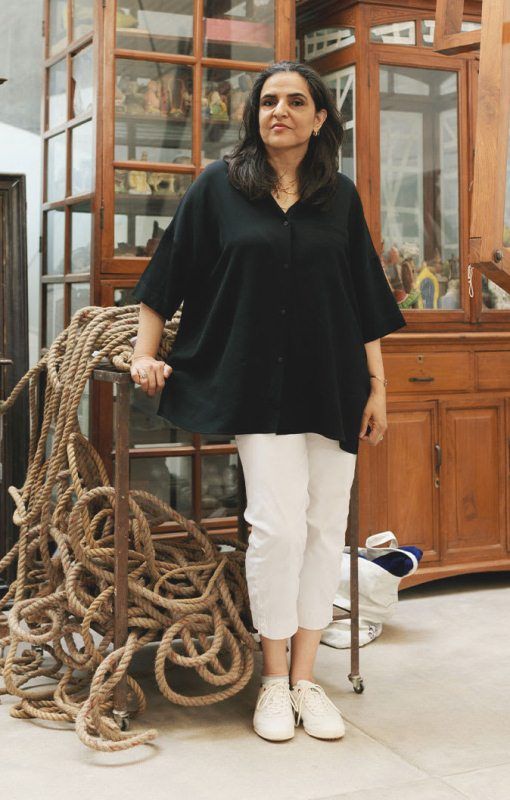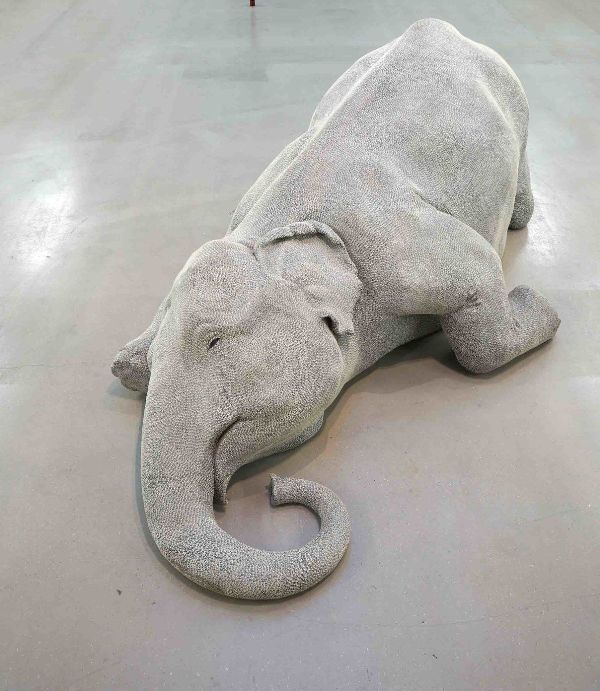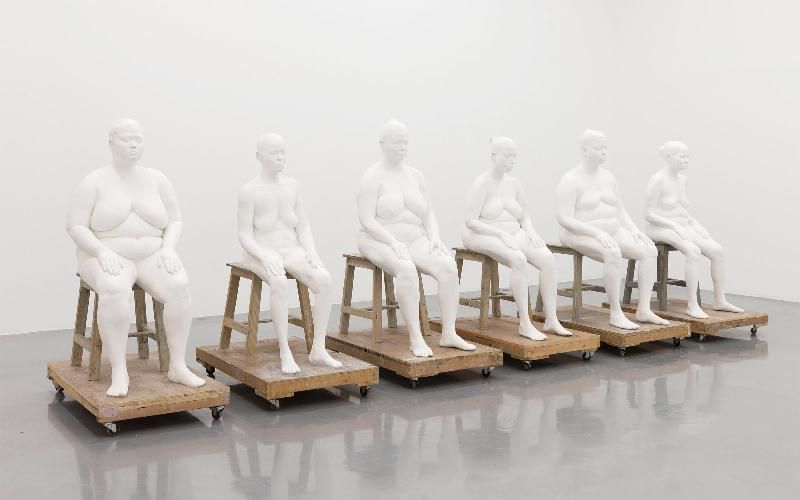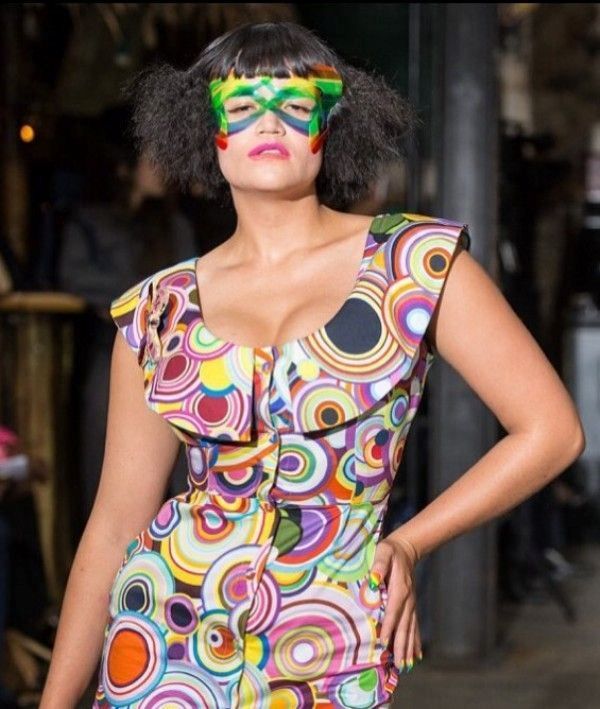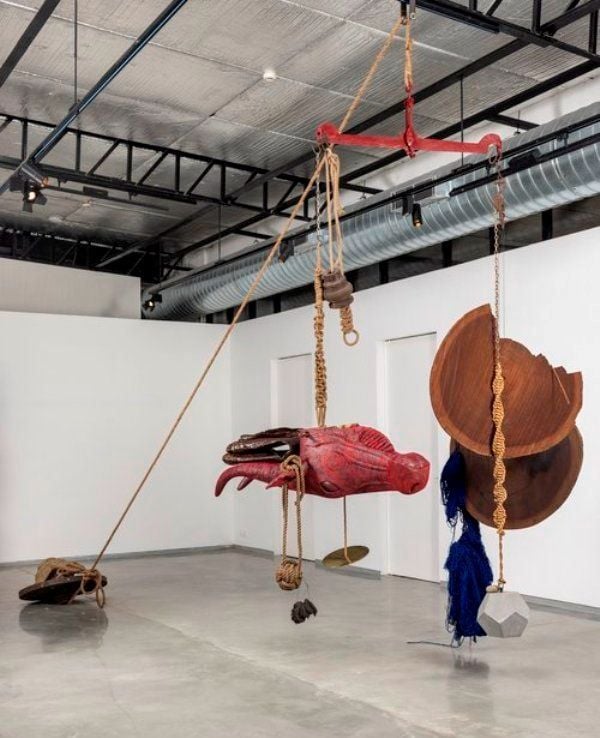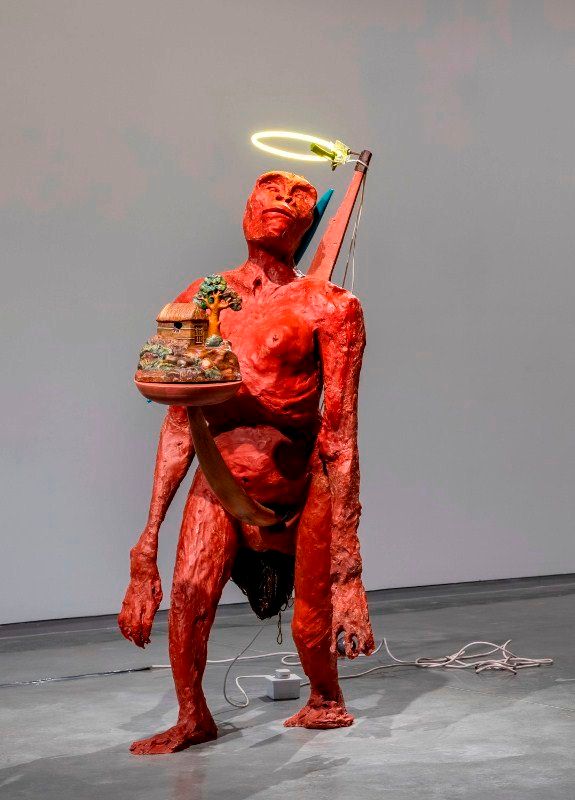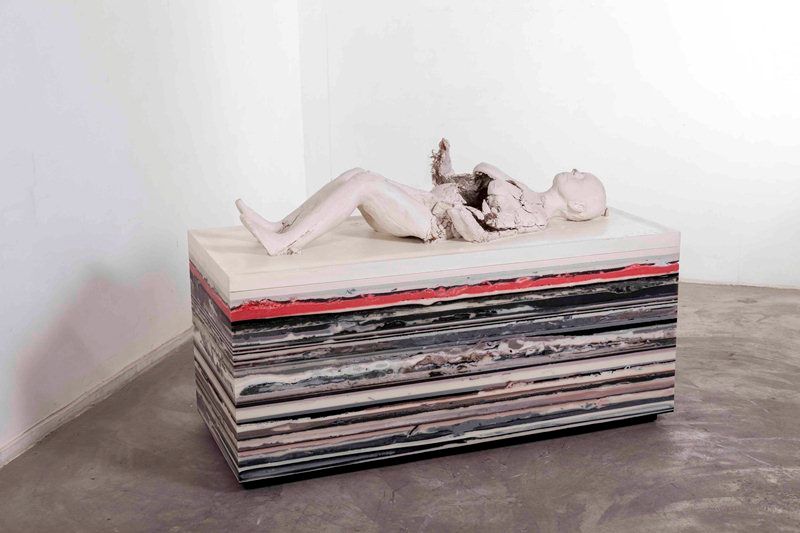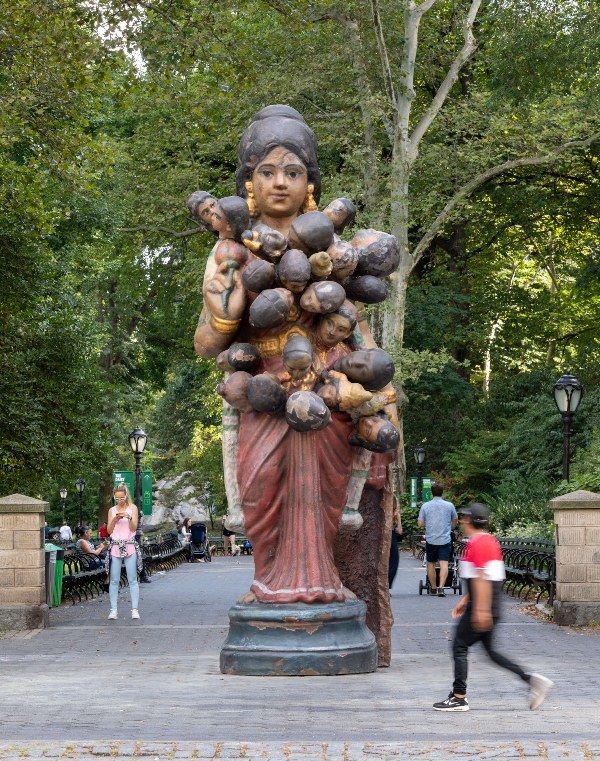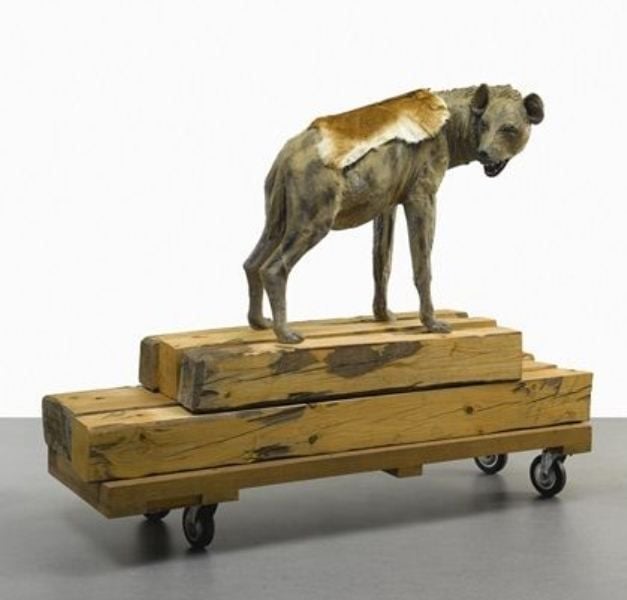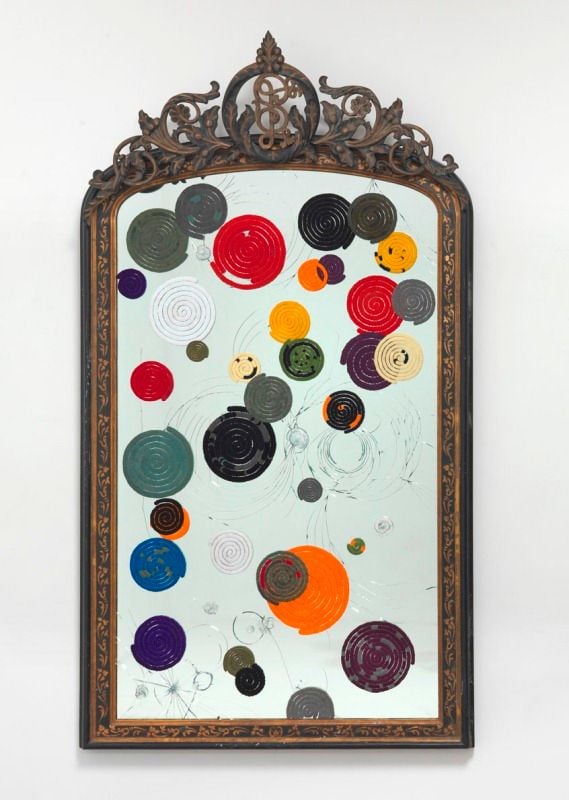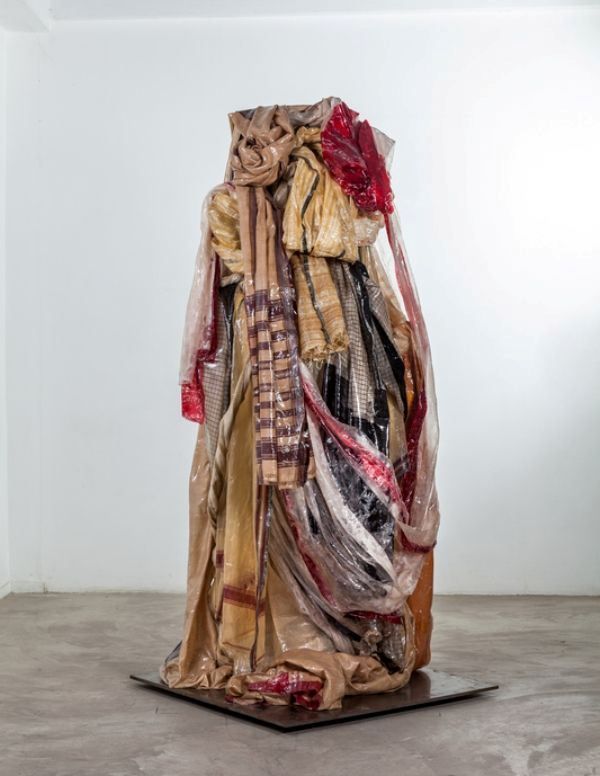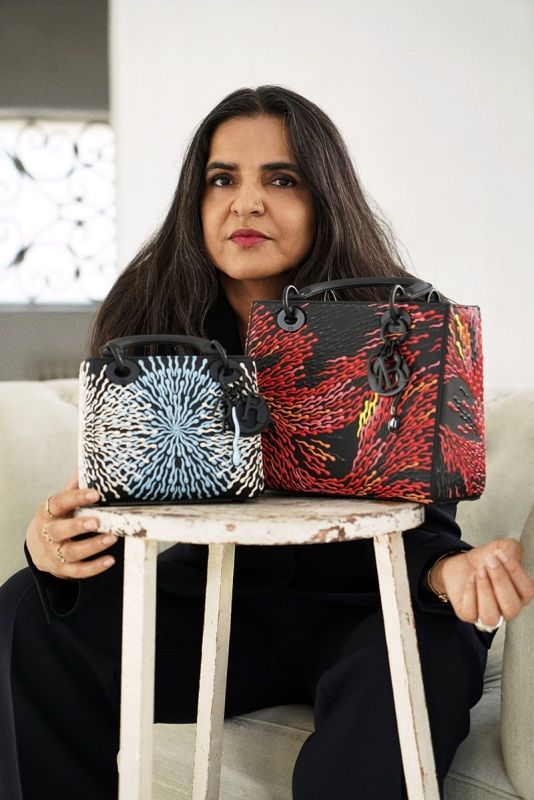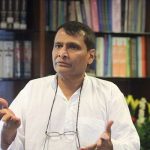Bharti Kher, Age, Husband, Family, Biography & More
| Bio/Wiki | |
|---|---|
| Profession | Artist |
| Physical Stats & More | |
| Height (approx.) | in centimeters- 167 cm in meters- 1.67 m in feet & inches- 5’ 6” |
| Eye Colour | Black |
| Hair Colour | Black |
| Career | |
| Artforms | • Sculpture • Installation • Paintings • Mirror Art • Saree Work |
| Themes | • Bindi Bharti Kher is mainly known for using bindi as her signature motif in her artwork. In Indian culture, a bindi symbolises third eye, which is usually applied by women on the centre of their forehead as an adornment. Kher has been using bindi in her artwork as a “code, a text, a membrane, and skin” for more than two decades. In an interview, she talked about making bindi as her signature motif, and said, “To conceal things, to open them up, focus your eye towards a specific point on a sculpture, to lead you in. And the most interesting thing for me is it’s a language that I’ve developed for myself and my own practise, and nobody else has it. So, it’s mine. I can speak it now.” [1]Open Some of her notable works under this theme include 'Future is not fixed (series)' (2020), 'Maps (series)' (2015-17), 'Formless connections' (2016), 'Dark Matter MM' (2015), and 'Code, cell, grid' (2013). 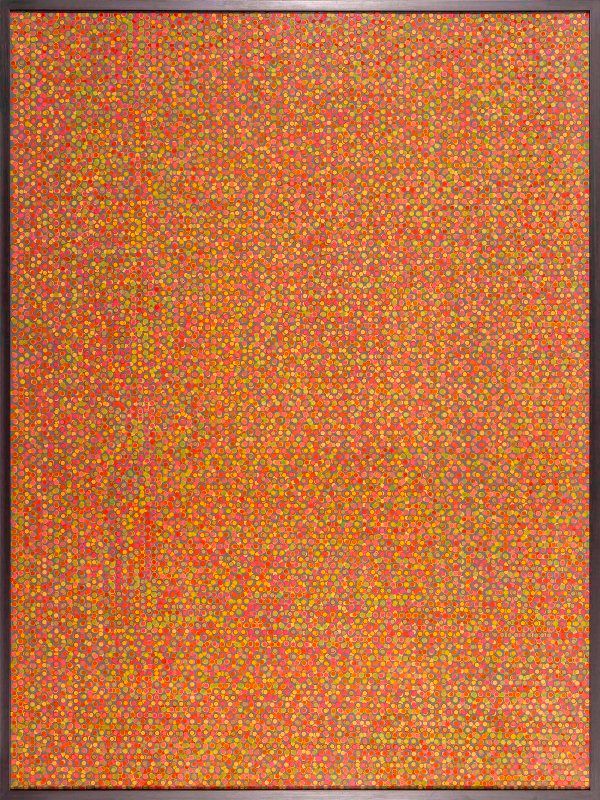 • Intermediaries Bharti Kher uses the theme of intermediaries in her artworks to express her ideas of transformation and deconstruction of narratives. In her “Intermediaries” series, she created art pieces by putting together different readymade coloured clay figurines (murti), giving them a new form and meaning. She mainly uses figurines of humans, animals, and objects in her intermediaries series. Some of her notable works from this series include 'Yes no' (2020), 'The Fallow' (2019), 'Talisman' (2019), 'Sisters' (2019), 'The offspring of a deity perhaps' (2019), 'The Intermediary family' (2018), and 'Ardhanarishvara' (2016). 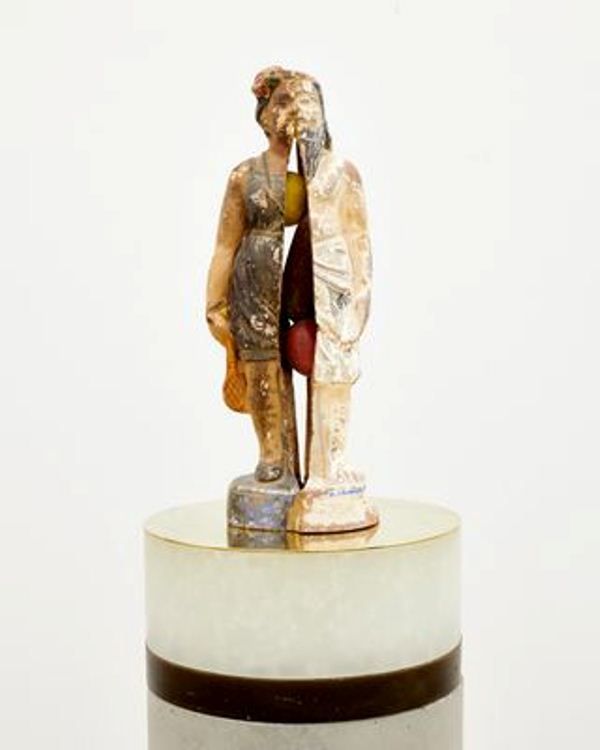 • Women and the Body By using the theme ‘Women and the Body’ in her artwork, Kher tries to express the status of women in a society. Apart from making plaster sculptures of women, she also make use of adornments used by Indian women, such as bindi and saree under this theme. She uses raisin-dipped sarees to make wall arts, sculptures, and saree portraits. In her unique way of making portraits by using sarees, she make use of objects to personify. To make these saree portraits, Kher use resin-dipped sarees, cement pillars, wooden chairs and staircases. She moulds and folds the sarees in her portraits in such a way that depicts the presence of the person for whom it is made. In an interview, she talked about the idea behind making saree portraits and said, "The saree women came out of this idea of absence and presence of the body.” [2]Open Some other works based on the theme of 'Women and the Body' are 'The Hybrid series' (2004), 'Mrs Hera Moon' (2006), 'Arione’s sister' (2006), 'Lady with an Ermine (2012), and Six Women' (2013-15). 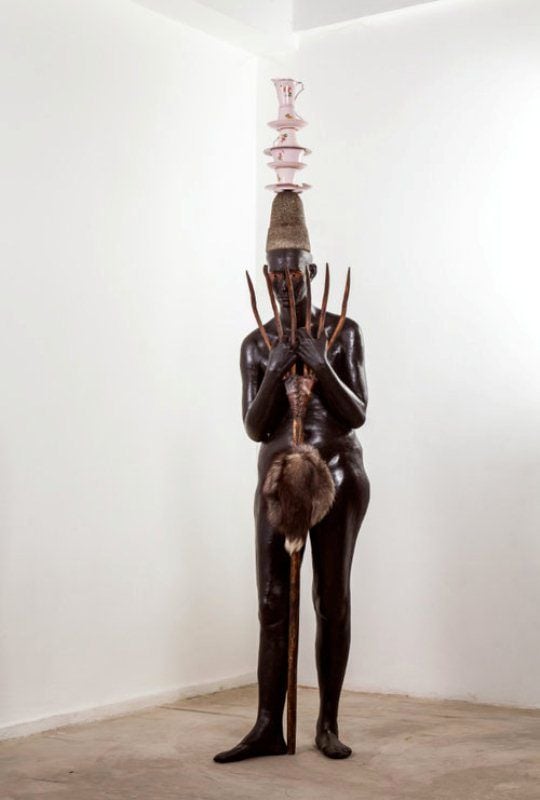 |
| Solo Shows | • AIFACS, New Delhi, India (1993) • Art Heritage, (cat), New Delhi, India (1995) • Galerie F.I.A, Amsterdam, Netherlands (1997) • "Telling Tails" in New Delhi, India and "Telling Tails," Galerie F.I.A, Amsterdam, Netherlands (1999) • "The Private Softness of Skin" at Bose Pacia Modern in New York (cat), USA (2000) • "The Private Softness of Skin" at Gallery Chemould in Mumbai, India (2001) • "Quasi-, mim-, ne-, near-, semi-, -ish, -like," at Gallery Ske in Bangalore, India and "Hungry Dogs Eat Dirty Pudding" at Nature Morte in New Delhi, India (2004) • "Do not meddle in the affairs of dragons, because you are crunchy and taste good with ketchup," at Gallery 88 and Ske Gallery in Mumbai, India (2006) • "An absence of assignable cause" at Jack Shainman Gallery in New York, U.S.A. and "An absence of assignable cause" at Nature Morte in New Delhi, India (2007) • "Sing to them that will listen" at Galerie Emmanuel Perrotin in Paris and "Virus" at BALTIC Centre for Contemporary Art, Gateshead, UK (2008) • "disturbia, utopia, house beautiful" at Gallery SKE in Bangalore, India and "Inevitable undeniable necessary" at Hauser & Wirth in London (2010) • "Leave your smell" at Galerie Emmanuel Perrotin in Paris (2011) • "Many, (too) many, more than before" at Galerie Perrotin in Hong Kong, Bharti Kher, Parasol Unit Foundation for contemporary art, London, and "The hot winds that blow from the West" at Hauser & Wirth in New York (2012) • "Anomalies" at Kukje Gallery in Seoul, Korea and "Bind the Dream State to your Waking Life" at Nature Morte in New Delhi, India (2013) • "three decimal points. of a minute. of a second. of a degree" at Hauser & Wirth, Zurich and "Misdemeanors" at Rockbund Art Museum in Shanghai, China (2014) • "Not All Who Wanders Are Lost" at Isabella Stewart Gardner Museum in Boston, USA (2015) • "The Laws of Reversed Effort" at Galerie Perrotin in Paris, "This Breathing House" at Freud Museum in London, "BHARTI KHER Matter" at Vancouver Art Gallery in Canada, and "In Her Own Language" at Lawrence Wilson Art Gallery, Perth, Australia (2016) • "Bharti Kher: Sketchbooks and Diaries" at Isabella Stewart Gardner Museum in Boston, USA and "Dark Matter (MM)" at Museum Frieder Burda Salon Berlin, Germany (2017) • "Djinns, things, places" at Galerie Perrotin in Tokyo, Japan, "Messengers" at Grunwald Gallery of Art, Indiana University, Bloomington, USA, "Chimeras," Pasquart Kunsthaus Centre d'art, Biel/Bienne, Switzerland, and "Points de départ, points qui lient," at DHC/ART Foundation for Contemporary Art, Montreal, Canada (2018) • "A wonderful anarchy" at Hauser & Wirth, Somerset, Bruton, UK (2019) • "A Consummate Joy" at IMMA in Dublin, Ireland and "The Unexpected Freedom of Chaos" at Galerie Perrotin in New York (2020) • “Strange Attractors” at Nature Morte in New Delhi, India (2021) • “Ancestor” at Public Art Fund, Doris C. Freedman Plaza, Central Park, New York, USA (upcoming) (2022) |
| Group Shows | 1990 • Fresh Art, the National Fine Arts Degree Fair, the Business Design Center, London, UK • Squires Gallery, Newcastle Polytechnic, Newcastle upon Tyne, UK 1991 • Aspects of British Figurative Painting (1988-93), Milton Gallery, London, UK 1993 • Trends in Contemporary Indian Art, Art Heritage, New Delhi, India 1995 • 6th Bharat Bhawan Biennal of Contemporary Indian Arts, Bhopal, India • Sakshi Gallery, Mumbai, India • Postcards for Gandhi, a Sahmat Exhibition in five cities in India 1996 • Royal Overseas League Open Exhibition, Overseas House London, Edinburgh College of Art, UK • Of Women Icons/Stars/Feasts, Eicher Gallery, (cat), New Delhi 1998 • Edge of The Century, curated by Amit Mukopadya, British Council, (cat), New Delhi, India • Cryptograms, Lakeeren Art Gallery, (cat), Mumbai, India 1999 • Impact, curated by Jim Beard Gallery, Amsterdam at CCA New Delhi, India • Embarkation’s, curated by Yashodra Dalmia, Sakshi Gallery (cat), Mumbai, India • Icons of The Millenium, curated by Lakeeren Art Gallery, Nehru Centre, (Cat), Mumbai, India • Boxwallahs, Art in a Public Space with De Ego, a collaborative work with Subodh Gupta at Sahay Filling Station, Gurgaon/ Mehrauli Road, N.H.8, India • Hed end aagse Kunst uit India, Central Bureau Vande Hogeschool, Amsterdam, The Netherlands 2000 • Open Circle Exhibition, Lakeeren art Gallery, (cat), Mumbai, India • of, based on, or obtained by (Tradition), Nature Morte, New Delhi • Aar Paar, an exchange between five Indian and Pakistani artists, curated by Shilpa Gupta and Hema Mulji, at Kundan Pan Shop, Karachi, Pakistan 2001 • Art On The Move, a Sahmat Project curated by Vivan Sundaram, in 5 venues in Delhi, India • Kitch Kitch Hota Hai, curated by Madhu Jain for Gallery Espace, India Habitat Center, (cat), New Delhi, India 2002 • Under Construction, Tokyo Opera City Art Gallery, (cat), Tokyo and Japan Foundation, Japan • Khoj Residency Show, Khoj Studios, New Delhi, India • Creative Space, Sakshi Gallery, at Habitat Centre, (cat), New Delhi, India • Photosphere, curated by Peter Nagy, Nature Morte, New Delhi, India • Playgrounds & Toys, ART for The World, Geneva, in Delhi with Nature Morte • Cutting Edge Contemporary, curated by Art Edge, NGMA Mumbai, Interiors Espana, New Delhi, India • GLUE, curated by Peter Nagy at Sumukha Gallery, Bangalore, India • Borderless Terrain, curated by Alka Pande, India Habitat Center, (cat), New Delhi, India • Silence Violence, NSA Gallery, a Pulse Project, curated by Greg Streak Durban, NieBethesda and Stellenbosch, South Africa • MANGO, A SAWCC show for Talwar Gallery, New York, USA • Sorry For The Inconvenience, curated by Gridthya Gaeweewong for Japan Foundation, at Project 304, Bangkok, Thailand and Tokyo Opera City Art Gallery Tokyo (Cat) • Sidewinder, curated by Gerard Hemsworth for CIMA Gallery, Kolkata, India 2003 • Crossing Generations: diverge, curated by Geeta Kapur and Chaitanya Sambrani for 40 years of Gallery Chemould, (cat), Mumbai, India • The Tree from the Seed: Contemporary art from India, curated by Gavin Jantjes, Henie Onstad Kunstsenter, (Cat), Norway • Sirpur Paper Mills, workshop Exhibition, at Art Inc, New Delhi, India • Bad Taste, Apparao Gallery, at The Apeejay New Media Centre, New Delhi, India 2004 • Contemporary Art From India, Thomas Erben Gallery, New York, USA • Vanitas Vanitatum, curated by Peter Nagy for Sakshi Gallery, Mumbai, India • The SNEEZE, a Featured Film 80 artists x 80 seconds 106 minutes, curated by Natasha Makowski and Peter Lloyd Lewis, (cat), Athens, Greece • Adrogyne, curated by Alka Pande at India Habitat Center, New Delhi, India 2005 • Zeitsprunge Raumfolgen curated by Simone Wilke, IFA Galerie Berlin and Stutgard, (cat), Germany • Mom and Pop, Walsh Gallery, Chicago, USA • Indian Summer, curated by Deepak Anand and Jany Luga, ENSBA, (cat), Paris • Indian Summer, Nature Morte, New Delhi • Het offer/ an intimate I: droom en werkelijkheid, De Beverd Museum voor Grafische werkeljkheid, Breda 2006 • Fuori Uso 2006- Altered States. Are you experienced? curated by Nicolas Bourriaud and Paolo Falcone, Ex Mercato Ortofrutticolo, Pescara, Italy • Asia Pacific Triennale, Queensland Art Gallery, (cat), Brisbane, Australia • Le troisième Oeil, Lille 3000, curated by Caroline Naphegyi, (cat), Lille, France • Inside outside, Nature Morte, New Delhi, India • Hungry Gods, Arario Gallery, (cat), Beijing, China • Made By Indians, Galerie Enrico Navarra, Art on the beach, (cat), St Tropez, France • Long Happy Hours Thereby Happiness & Other Stories, Gallery Chemould at The Museum Gallery, Mumbai, India 2007 • The Sneeze 80×80, curated by Peter Lloyd Lewis and Natasha Makowski, Cape Town, Durban • International exhibition of sculptures and installations, organised by Arte Communications and the Department of culture of the Venice City Council. • Urban Manners. Contemporary Artists from India, curated by Adelina von Furstenberg at Hangar Bicocca in collaboration with ART for the World Europa, Milan, Italy • Indian Photo and Media Art: A Journey of Discovery, FLUSS – NÖ Initiative for Photo-and Media Art, Weinviertel, Austria • Private/Corporate IV, Sammlung DaimlerChrysler- Lekha and Anupam Poddar Collections, Berlin, Germany 2008 • Indian Highway, curated by Julia Peyton-Jones, Hans Ulrich Obrist, Serpentine Gallery, London, UK • Mutant Beauty, Anant Art Gallery, curated by Gayatri Sinha at the Anant Art Gallery, New Delhi • Chalo! India: A New Era of Indian Art, Mori Art Museum, Tokyo, Japan • Indian Focus, Espace Claude Berri, Paris • Everywhere is war, Bodhi Art Bombay, curated by Shaheen Merali, (cat.) • Still moving Image, Devi Art Foundation, curated by Deeksha Nath at the Devi Art Foundation, Gurgaon, India (cat.) • Expenditure, the Busan Biennale, directed by Kim, Won-Bang at The Busan Museum of Modern Art, Korea • Comme des bêtes, (Like animals), Fine Arts Museum in Lausanne, Switzerland, curated by Bernard Fibicher • Re-imagining Asia, A thousand years of separation, curated by Shaheen Merali and Wu Hang, at the House of world cultures (cat) • Distant Nearness, The Nerman Museum of Contemporary Art at Johnson County Community College, Kansas, USA • Passage to India, Frank Cohen Collection at Initial Access Wolverhampton, UK • India – Guest in the Giant, RAIN.bow.PEARLS, organized by Swarovski at the Kristallwelten • New Delhi – New Wave, Primo Marella Gallery, Milano, Italy (cat.) 2009 • Who’s Afraid of the Artists? A Selection of Works from the Pinault Collection, Palais des Arts de Dinard, France • Bharti Kher, Yayoi Kusama, Eva Rothschild, Mindy Shapero, Marianne Boesky Gallery, NY • Les Artistes Indiens d’Aujourd’hui, Palais Bénédictine, Fécamp, France • Where in the world, curated by Kavita Singh, Shukla Sawant and Naman Ahuja, Devi • Art foundation, New Delhi, India • Chalo! India: A New Era of Indian Art, Essl Museum, Vienna, Austria • Chalo! India: A New Era of Indian Art, The National Museum of Contemporary Art Museum, Seoul, Korea • Indian Highway, curated by Gunnar B. Kvaran, Astrup Fearnley Museum of Modern Art, Oslo, Norway 2010 • Tokyo Art Meeting. Transformation, Museum of Contemporary Art, Tokyo, Japan • Pattern ID, Akron Art Museum, One South High Akron Ohio, US • The Empire Strikes Back: Indian Art Today, The Saatchi Gallery, London • Tauba Auerbach, Matthew Day Jackson…, Galerie Emmanuel Perrotin, Paris • Gothenburg Culture Festival Gothenburg, Sweden • Lille3000: The Silk Road. Saatchi Gallery London in Lille, Tri Postal, Lille • Indian Highway, Herning Kunstmuseum, Denmark • Signs of Life. Ancient Knowledge in Contemporary Art, Kunstmuseum Luzern, Lucerne • Susan Hefuna, Bharti Kher, Fred Tomaselli: Between the Worlds, Kunstmuseum Thun, Switzerland • Facing East: Recent Works from China, India and Japan from the Frank Cohen Collection, Manchester Art Gallery, England • Pattern ID, Akron Art Museum, US 2011 • Indian Highway V, MAXXI Museum, Rome • Seduction by masquerade, Nature Morte, Delhi, India • Paris Delhi Bombay, Centre Pompidou, Paris • Indian Highway IV, Museé d’art contemporain de LyonFestival der Tiere, Essl Museum, Klosterneuburg, Austria • Maximum INDIA, John Kennedy Center for the Performing Arts, Washington, DC 2012 • Misled by Nature: Contemporary Art and the Baroque, Art Gallery of Alberta, Canada (Travelling Exhibition) • Dot. Systems. From Pointillism to Pixelation, Wilhelm-Hack-Museum, Germany • La Belle & la Bête, Institut Culturel Bernard Magrez, Bordeaux, France • India: Art Now, Arken Museum of Modern Art, Denmark • The First Kyiv Biennale of Contemporary Art: The best of times, the worst of times. Rebirth and apocalypse in contemporary art’, Kyiv, Ukraine • Critical Mass, Contemporary art from India, Tel Aviv Museum of Art, Israel 2013 • Textile – Fabric as Material and Concept in Modern Art from Klimt to the Present, Kunstmuseum Wolfsburg, Germany • Quartiers d’été, Collection de l’Institut Culturel Bernard Magrez, villa les Roches Brunes, Dinard, France • Trade Routes, Hauser & Wirth, London, England • We are Ours: A Collection of Manifestos for the Instant, Khoj International Artists’ Association, New Delhi, India • Art & Textiles – Fabric as Material and Concept in Modern Art from Klimt to the Present, Kunstmuseum Wolfsburg, Wolfsburg, Germany 2014 • Whorled Explorations, Kochi-Muziris Biennale, Kochi, India • Girl – curated by Pharrel Williams, Galerie Perrotin, Paris • Entre deux expositions. Collections et nouvelles acquisitions de l’Institut, Institut Culturel Bernard Magrez, Bordeaux, France • Here Today…A major exhibition marking 50 years of the IUCN Red List, The Old Sorting Office, London 2015 • Go East: The Gene & Brian Sherman Contemporary Asian Art Collection, curated by Suhanya Raffel • Art Gallery of New South Wales, Sydney, Australia • Don’t Shoot the Painter – UBS Art Collection, Villa Reale’s Galleria d’Arte Moderna, Milan, Italy • Codes of Culture, SKE Gallery, New Dehli, India 2016 • I Prefer Life, Weserburg, Bremen, Germany • Present, Johyun Gallery, Busan, Korea • The Future Is Already Here – It’s Just Not Evenly Distributed, 20th Biennale of Sydney, Sydney, Australia 2017 • Fond illusions, Perrotin, New York, USA • Portable Art: A project by Celia Forner, Hauser & Wirth, Zurich, Switzerland • Versus Rodin: Bodies across space and time, Art Gallery of South Australia, Adelaide, Australia • Pizzuti Collection, Visions from India. Transforming Vision: 21st Century Art from the Pizzuti Collection, Columbus OH • Salon, Hauser & Wirth, Zurich, Switzerland • Sub-Plots: Laughing in the Vernacular, National Gallery of Modern Art, Mumbai, India • Approaching Land, Akara Art Gallery, Mumbai, India 2018 • Vision Exchange: Perspectives from India to Canada, Art Gallery of Alberta – Alberta, Canada • Facing India, Kunstmuseum Wolfsburg – Wolfsburg, Germany • Like Life: Sculpture, Color, and the Body (1300-Now), The Metropolitan Museum of Art, New York, USA • My Monster: The Human Animal Hybrid, RMIT Gallery, Melbourne, Australia • I See You, Savannah College of Art and Design, Savannah, USA • Surface Work, Victoria Miro, London, UK • The Sculpture Park, Madhavendra Palace at Nahargarh Fort, Jaipur, India • Bronze Age c.3500 BC-AD 2018, Firstsite, Colchester, England 2019 • Les arts du Tout-Monde, Musée des Beaux-Arts de Montréal, Montréal, Canada- Driving Forces: Contemporary Art from the Collection of Ann and Ron Pizzuti, Columbus Museum of Art and Pizzuti Collection of the Columbus Museum of Art, Columbus, USA • In the Company of Artists, 25 Years of Artists-In-Residence, Isabella Stewart Gardner Museum, Boston, USA • Desire in Art, from the 20th Century to the Digital Age, IMMA, Dublin, Ireland • Public Art Exhibition, Harvard Business School, Boston, USA • La Lumière des Mondes, Domaine des Etangs, Massignac, France • Vision Exchange: Perspectives from India to Canada, Winnipeg Art Gallery, Winnipeg, Manitoba, Canada • Vision Exchange: Perspectives from India to Canada, University of Toronto Art Centre, Toronto, Canada 2020 • Tantra: enlightenment to revolution, The British Museum, London, UK • Relations (Diaspora and Painting), Fondation Phi, Montreal, Canada • Contemporary Female Identities in the Global South, Joburg Contemporary Art Foundation, Johannesburg, South Africa • 21st-Century Art from the Pizzuti Collection, Columbia Museum of Art, Columbia, USA • Résonance, Fondation Opale, Switzerland • Animals in Art, Arken, Ishøj, Denmark • Dhaka Art Summit: Seismic Movements, Bangladesh • Vision Exchange: Perspectives from India to Canada, Mackenzie Art Gallery, Regina, Saskatchewan, Canada 2021 • Hub India: Classical Radical, Accademia Albertina di Belle Arti di Torino, Torino, Italy |
| Awards, Honours, Achievements | • 'Sanskriti Award' in 2003 • 'YFLO Women Achiever of the Year' award in 2007 • 'ARKEN Art Prize' in 2010 • 'Chevalier dans l’Ordre des Arts et des Lettres' (Knight of the Order of Arts and Letters of France) in 2015 for her contribution to the landscape of contemporary art, both in France and internationally |
| Personal Life | |
| Date of Birth | Year, 1969 |
| Age (as of 2023) | 54 Years |
| Birthplace | England |
| Nationality | Indian |
| Hometown | Delhi |
| College/University | • Middlesex Polytechnic, Cat Hill, London • Newcastle Polytechnic (now Northumbria University) |
| Educational Qualification | • Foundation Course in Art & Design from Newcastle Polytechnic • BA Honours in Fine Art and Painting (1988-1991) |
| Religion | Hinduism |
| Relationships & More | |
| Marital Status | Married |
| Affairs/Boyfriends | Subodh Gupta (artist) |
| Marriage Date | Year, 1993 |
| Family | |
| Husband/Spouse | Subodh Gupta (artist)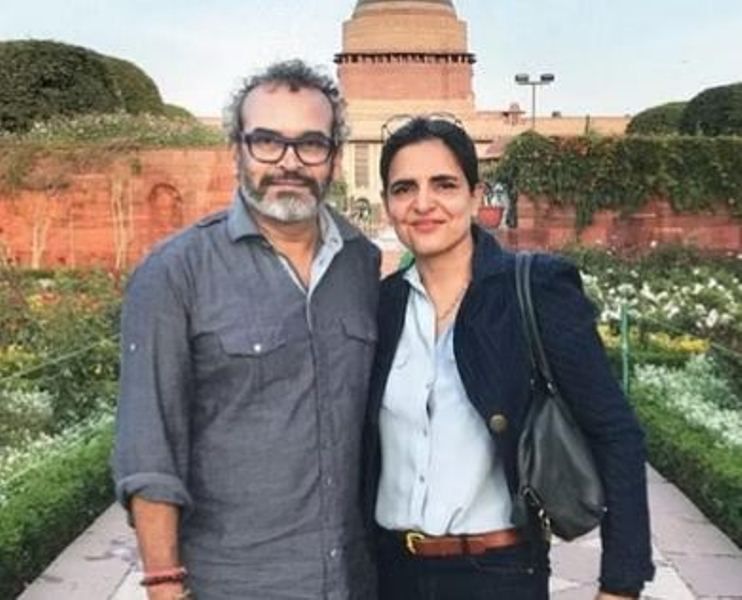 |
| Children | She has two children named Lola and Omi. [3]CNN |
| Parents | Bharti Kher’s father was a textile merchant, and her mother was a seamstress who had her own textile shop. |
Some Lesser Known Facts About Bharti Kher
- Bharti Kher is an England-born Indian contemporary artist. She is known for making sculptures, paintings, installations, and her most prominent saree portraits. Through her artwork, she tries to highlight issues like migration, identity, sexuality, femininity, social roles, gender relationships, traditional rituals, and the culture of India. Kher has worked with many famous art galleries such as Hauser & Wirth, Galerie Perrotin, GALLERYSKE, and Nature Morte.
- After completing her graduation in London in 1991, she decided to travel for which she had to make a choice between New York and New Delhi. She tossed a coin and decided to travel to New Delhi. In an interview, she revealed that she came to India for a few months, but when she met Subodh Gupta, she decided to stay in Delhi. She said,
I had no intention of staying in India; I just thought I’m going to travel around the country.” [4]The Womb
- The attribute of juxtaposing contradictory elements in her artwork and giving them a constructive meaning is what makes her artwork different from others. She takes inspiration from day-to-day life activities. The reflection of the culture of both England and India in her artwork shows her understanding of both cultures as she has spent her life in both countries.
- After making her first bindi artwork “Spit and Swallow” in 1996, Bharti Kher made a transition in her artwork by adding sculpture to her art forms. Before this, she only makes paintings. [5]Art Basel
- In 1997, Bharti Kher along with her husband Subodh Gupta, and some other artists, formed the Khoj International Artists’ Association to collect funds to help the artists. [6]The Better India
- The sculpture “The Skin Speaks a Language Not Its Own” (2006) by Bharti Kher is considered one of her ‘most talked about’ artworks. It is a life-sized sculpture of a female Indian elephant, made up of fibreglass layered with thousands of sperm-shaped bindis. According to Indian culture, the elephant in the sculpture represents Lord Ganesha, and the use of bindi represents peace and feminity; therefore, the artwork by Bharti Kher can be regarded as an apt archetype of India. In the sculpture, Bharti has shown the elephant lying on her knees, seeming peaceful and painful at the same time. She has left her viewers to analyse whether the elephant is trying to rise up or lying exhausted or died in her artwork. [7]Sotheby’s
- In 2010, Kher became the first Indian contemporary female artist to be counted among the big numbers league of Anish Kapoor, Raqib Shaw, and Subodh Gupta, after her artwork, ‘The Skin Speaks A Language Not Its Own,’ (2006) sold for approximately 7 crores at the Contemporary Art Evening Sale at Sotheby’s gallery. [8]The Economic Times
- Her art series ‘The Virus Series’ is a 30-year-long project that she started in 2010, and will complete by 2039. In this artwork, Kher created a swirling mass using bindi artwork along with text through which she gave her predictions. In an interview, she described her artwork and said,
For me, Virus is just an amalgamation of all the different interests that I have. Being alive, living, sexuality, contemporary politics, so many different things. And every year its marked by how old I am. The project started when I was 40 and will end when I am 70.” [9]The Week
- For her artwork, ‘Six Women’ (2013-2015), which consists of the sculptures of six women, Kher appointed six sex workers as her sitters. In this artwork, she portrayed the physique and the facial expression of the sex workers, which reflected their emotions. Through this artwork, Kher highlighted the issue of vulnerability that comes from the nudity of females. [10]Art Basel
- In 2016, the Indian fashion designer Manish Arora used Bharti Kher’s bindi theme to design a dress for a fashion show at ‘Paris Fashion Week SS17.’
- In her solo show, ‘Strange Attractors,’ which was held at Nature Morte Gallery, Delhi in 2021, she exhibited her mixed-media sculpture “A Natural Unity Of Opposites” made by a resin-coated saree, placed folded on the trunk of a buffalo, hanging from a rope, and balanced with circular wooden beams. The art piece is based on the idea of “knowing self,” which was coined by the Greek philosopher Aristotle. While explaining the art piece in an interview, she said,
The work describes the state of flux where chaos at all times could just be at a tipping point and yet there’s counterbalance and stability. We’re always managing many things, balancing things out like ourselves, families, our sense of well-being and anxieties.”
- In the same show, she exhibited another sculpture of a disfigured female monkey, who is balancing a tiny house on her tail. Through the sculpture, she might reflect the idea of existence and balance. In an interview, she talked about the sculpture and said,
She’s strange but for me, she’s the shaman. She welcomes you to this strange world where we’re not really sure what’s going or coming.” [11]The Indian Express
- Her sculpture “Pieta” is inspired by the Italian sculptor Michelangelo’s Renaissance sculpture of the same name ‘Pieta.’ In Michelangelo’s Renaissance sculpture, he has shown Mother Marry carrying the dead Jesus, whereas, Kher’s sculpture is a raw and weathered statue. In an interview, she said that she portrayed her mother through the sculpture, and said,
[Through Pieta] I am saying this is my mother and she is the old female ageing body. I wanted to engage with the idea of an old woman politically as well. She is not the revered goddess. I am not making her bigger than she is physically, but emotionally and psychologically this work is gigantic because our mother is the most significant person in our lives.” [12]The Week
- Her artwork “Ancestor” is a sculpture of an Indian woman who has 24 heads. It is a clay sculpture painted with some pastel shades and has a cracked and peeling surface. The artwork has been installed in the form of an 18 feet tall statue at Doris C. Freedman Plaza at the southeast entrance to Central Park, New York. In an interview, she gave an interpretation of the artwork and said,
The figure is a mother, but also contains the masculine.” The agglutinated heads represent “all her children,” she added — but also perhaps “her other selves.” [13]The New York Times
- Some more notable sculptures by Bharti Kher include ‘A Wonderful Anarchy’ (2019), ‘Mother and Child; Amar, Akbar, Anthony’ (2017), ‘Cloud Walker’ (2013), ‘The Messenger’ (2012), ‘Dominate’ (2011), ‘Warrior with cloak and shield’ (2008), and ‘Misdemeanours’ (2006).
- Bharti Kher is also known for her unique mirror art. In an interview, she talked about her mirror work “Cause and Effect,” which she made by using a cracked mirror and bindis, and said that she has amalgamated two contradictory ideas in this artwork, and gave it a new meaning. She said that according to Hindu beliefs, broken mirrors are considered a sign of bad luck, on the other hand, bindi represents peace, power, and feminity, and this artwork is a fusion of both, broken mirror and bindi. She said,
For me it was like if I break them, this is in a way my karma. My act of punk. And I sort of had this thing where it gives me the freedom. And when you break something, you free it from itself. It is an act of defiance, but also broken mirrors are gorgeous, so to turn something that is considered to be not beautiful and showing that it actually is, is something that I do quite a lot. I work with opposites.” [14]Open
- Some of her other famous mirror art includes ‘Indra’s net mirror (series),’ ‘The Starry Night after V.G.’ (2011), ‘Placebo landscape’ (2019), ‘The single white line that heard the future calling’ (2019), and ‘Gentle Bitch’ (2020).
- Bharti Kher uses resin-dipped sarees to make wall art, sculptures (by wrapping sarees on chairs or wooden staircases), and saree portraits. The admirers of her artwork consider her saree portraits incredible, which she makes by wrapping resin-dipped sarees on cement pillars in a way that reflects the characteristics of the person to whom the portrait is dedicated.
- In 2018, she made the saree portrait “Cloak for MM” as a tribute to Mrinalini Mukherjee, who died in 2015. Mrinalini Mukherjee was a renowned sculptor and Bharti’s close friend. To make this portrait, Kher used Mukherjee’s own sarees, which made this artwork more realistic.
- In 2020, she designed the bags for the Christian Dior company, Lady Dior, using her signature bindi motif. She brought together two cultural elements i.e., Indian bindi and western Christian Dior company in this project. In an interview, she talked about the idea behind this project and said,
It’s two signatures; you join them and you have a hybrid. It was seamless. And since I am a sculptor, I don’t think of a bag as any different from any other three-dimensional surface.” [15]Vogue
- In 2021, she made the saree portrait “Benazir,” which was based on the life and assassination of the Pakistani politician Benazir Bhutto, who had made predictions about her assassination. The portrait consists of five holes that represent the five bullet shots on her body.
- Some other notable saree portraits made by Bharti Kher include ‘Portrait Manju’ (2013), ‘My friend unnamed’ (2014), and ‘Portrait Nirmila’ (2017).
- Apart from the saree portraits, Kher is also known for her saree wall arts and installations among which some of the most notable include ‘Man woman I’ (2012), ‘Dominate’ (2011), ‘I find a way to keep it all together’ (2011), and ‘Many ways to say the same thing’ (2010).
References/Sources:

